A win for Indigenous Groups Protecting the Planet
Air Date: Week of November 15, 2024
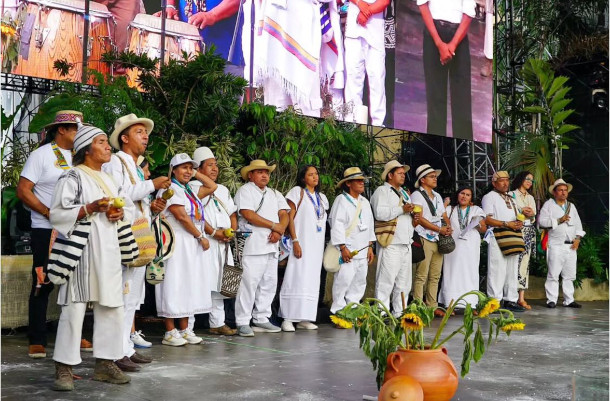
Kankuamo at COP16 in Cali, Colombia during the “viva paz con naturaleza” or the “peace with nature event”. (Photo: Courtesy of Carmen Rosa Guerra Ariza)
This year’s 16th meeting for the UN Convention on Biological Diversity was suspended as negotiations ran overtime and delegates needed to catch flights home. But earlier in the talks, a decision was reached to give indigenous communities a proper seat at the table moving forward. Carmen Rosa Guerra Ariza is delegate from one such indigenous community, the Kankuamo people, and she joins Host Aynsley O’Neill to discuss this win.
Transcript
O’NEILL: As we reported last week the 16th conference for the UN treaty known as the Convention on Biological Diversity was suspended in disarray as the talks ran out of time to have a quorum. But early on, the negotiations yielded a landmark agreement to form a subsidiary body that specifically recognizes the role of Indigenous peoples in future conservation decisions. With indigenous peoples often known for their long and significant role in environmental conservation, this has been a fight for first nations groups worldwide. One such group is the Kankuamo people, who live in Colombia where the conference took place. Their ancestral lands are in the Sierra Nevada mountains, a place that is referred to as “the heart of the world” and is surrounded by a virtual border called the “Black Line” that connects over 300 sacred sites for the four indigenous nations that live there. Along with their neighbors, the Kankuamo people have dedicated much of their time and energy to protecting these lands, these days mostly from mining threats. For more, we turn now to Carmen Rosa Guerra Ariza. She serves as the Global Agenda Coordinator of the Indigenous Kankuamo Organization and joins me to share how her community is connected to the land and to reflect on this year’s biodiversity talks at COP 16. Carmen welcome to Living on Earth!
GUERRA: Thank you for having me and thank you all for allowing me to talk about my territory… And zuminjano, that means good morning in my language.
O'NEILL: Wonderful. So please tell us about your indigenous community, the Kankuamo.
GUERRA: The Kankuamo indigenous nation is one of four indigenous nations that live in the Sierra Nevada of Gonawindua, the heart of the world, the north of Colombia. We are being ancestrally protecting our territory that we believe that is the heart beating in the life system of the Mother Earth. And we are promoting the protection of the traditional spiritual sacred places that we have around the Sierra Nevada and that a half a name the Black Line. And the Black Line is the connection of those really specific spiritual places that protect the whole humanity for everything. And since we have knowledge, we have been doing that.
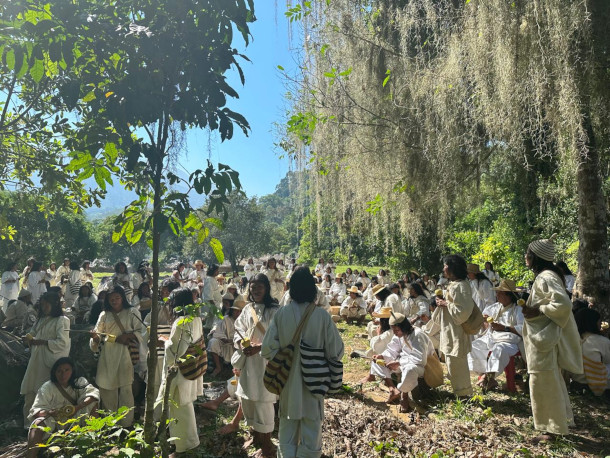
Kankuamo community gathering in their ancestral territory of the Sierra Nevada of Gonawindua. (Photo: Courtesy of Carmen Rosa Guerra Ariza)
O'NEILL: So, Carmen, could you tell us a little bit more about this term, the Black Line?
GUERRA: Of course, the black line is this series of sacred places that are around the Sierra Nevada of Gonawindua and that actually protect the Sierra Nevada of Gonawindua. Each of the sacred places have a purpose. For example, you have a place for healing. You had a place for knowing things. You can have a place for getting birth. You can have a place for, for many, many purposes. And the important part of these spiritual traditional places is that they need to be protected.
O'NEILL: So yes, you referred to the Sierra Nevada Mountains as the heart of the world. Where did that name come from?
GUERRA: Well, that is our traditional knowledge. So, we are basically protecting the heart of the world that is allocated there. It's not like we need to overthink about it, it is, it is. Since we exist in that territory, we are being protecting Mother Earth. So, we believe that we have nine worlds, four on top, four in the bottom, and in the middle is the earth. And all these words are connected in our traditional knowledge system. And that's why we know that the heart of the world is in our territory. It's the same, like the lung of the world. You know, the Amazon, in their traditional knowledge, they are protecting the lung of the world because they are allowing the Mother Earth to breathe through their territory.
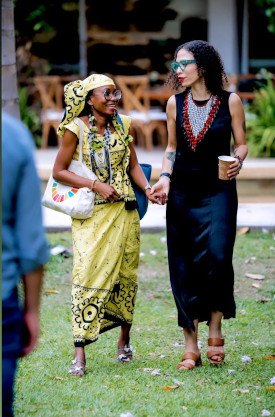
Hindou Oumarou Ibrahim (left), president of UN Permanent forum for indigenous issues alongside Carmen Rosa Guerra Ariza (right). (Photo: Courtesy of Carmen Rosa Guerra Ariza)
O'NEILL: And can you describe the Sierra Nevada for us? You know, what does it look like? And how does it feel to live there?
GUERRA: Well, it's not because it's my territory, but it's beautiful. It's the perfection itself. It have all the temperatures, so you have a snow in the top, and you have the beach at the bottom, so you can actually visit the top, and you are going to be with jacket, and then you are going to be in bathing suit because you are in the beach. But also, is really a specific each territory. We are four indigenous nations. So, we are all together protecting our territory, and we all have kind of the same tradition. So that's why we only have one traditional knowledge system. So, we are a really strong and resilient indigenous nation. In my community, you can have a lot of hummingbirds, a lot of real nature, like, you have many butterflies in my territory, you have many trees. You have mango trees. I love mango. And you have many, many options of mangoes. And you have many traditions connected to Sacred plants, first, but second, plants for healing and plans for eating. So, it's a really close connection to the territory.
O'NEILL: Now, what are some of the environmental threats that the Kankuamo people are facing?
GUERRA: The Sierra Nevada is so rich that you can find a lot of things, metals and rich minerals, beautiful things that belong to territory. It needs to be in the territory, but the economic and capitalistic approach always overpass that necessity to protect the territory. So, because of that, you have, like, more than 100 a request of prior consultation, we don't have settled yet in Colombia. We have prior consultations in our territory. And I'm not talking only about the Kankuamo, because, as I said, we are four indigenous nations, the Kankuamo, the Wiwa, the Kogui and the Arhuaco people, and we are all defending our territory, and we are all in the same page that we don't want mining in the territory.
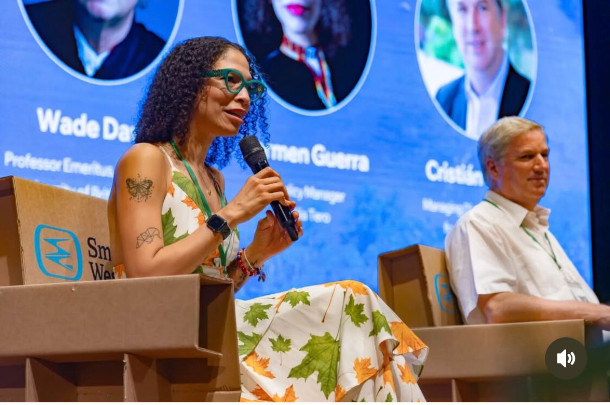
Guerra Ariza talking about indigenous knowledge during Half Earth Day at COP 16. (Photo: Courtesy of Carmen Rosa Guerra Ariza)
O'NEILL: And how do Colombia's indigenous communities protect nature and the environment?
GUERRA: Well, first, we understand that we are not protecting Mother Earth. It's on the contrary, Mother Earth is protecting us. The first message that we send in COP 16 was that. A reminder to the humanity, because, you know, humans can be really arrogant. Second, that relationship, acknowledging that allows you to recognize that you are part of the Mother Earth. So, behaving in that way, behaving in a respectful way because you are part of you are not over Mother Earth, you are part of Mother Earth. In that way, you can protect but also something that is absolutely important for every single indigenous nation that I know and for sure, for the heart of the world is the spiritual protection to Mother Earth. So, we are connected through our spiritual authorities, the Mamos and the Sakas, they are our traditional spiritual authorities that guide us and that have this deep connection with Mother Earth. Actually, they can interpret Mother Earth in showing us what is Mother Earth saying or suggesting or even advising, because Mother Earth is a living being.
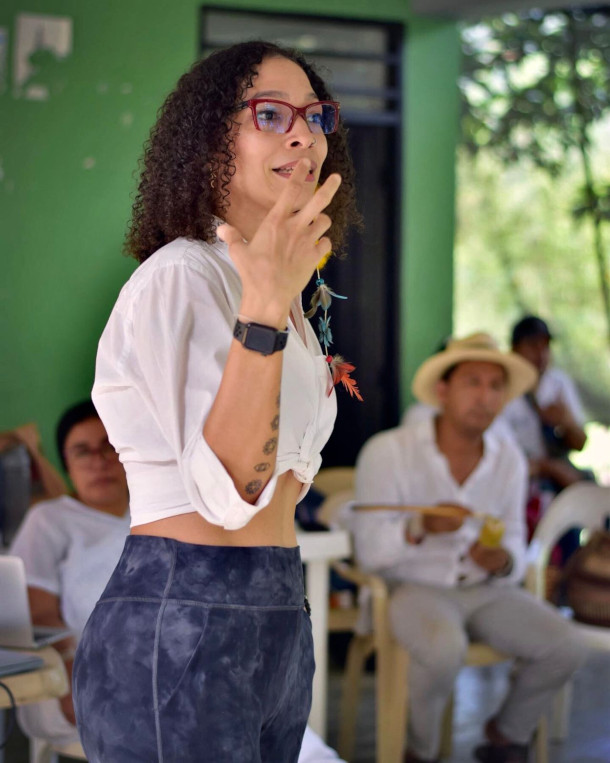
Carmen Rosa Guerra Ariza talking about COP16 to the Ponton community inside Kankuamo territory. (Photo: Courtesy of Carmen Rosa Guerra Ariza)
O'NEILL: Now you were at the recent UN biodiversity conference COP16, which was in Cali, Colombia. What role did indigenous nations have in this conference?
GUERRA: Well, first of all, for the biodiversity conference, I do feel that the indigenous movement had an strong pathway. So, since the COP 3, we have the IIFB, the International indigenous forum of biodiversity, and that build the capacity for having a caucus that actually acknowledge all the issues on biodiversity in a settled way. In our traditional system, knowledge system, is also important to generate the practical approach of the protection of what the convention of biodiversity want to achieve. At the end of the day, we are giving our life for our territories, and we are protecting key ecosystem in the whole world, in the seven sociocultural regions. So that's why our role is absolutely specific, but also important, because even the parties need to acknowledge that in every single way that the Western approach is being failing, we are having success.
O'NEILL: Carmen Rosa Guerra Ariza is the Global Agenda Coordinator of the indigenous Kankuamo organization. Thank you so much for your time with me today, Carmen.
GUERRA: Thank you so much you guys and hasay, hasay.
O’NEILL: The new formal body was created to give indigenous communities a proper seat at the table in the negotiations going forward. And in light of the lack of quorum at the end of COP16, those negotiations will continue at an interim meeting next year in Bangkok, Thailand.
Links
United Nations | “COP16: Landmark Biodiversity Agreements Adopted”
Learn more about the Kankuamo people
Learn more about Carmen Rosa Guerra Ariza
The Guardian | “COP16 Ends in Disarray and Indecision Despite Biodiversity Breakthroughs”
Living on Earth wants to hear from you!
Living on Earth
62 Calef Highway, Suite 212
Lee, NH 03861
Telephone: 617-287-4121
E-mail: comments@loe.org
Newsletter [Click here]
Donate to Living on Earth!
Living on Earth is an independent media program and relies entirely on contributions from listeners and institutions supporting public service. Please donate now to preserve an independent environmental voice.
NewsletterLiving on Earth offers a weekly delivery of the show's rundown to your mailbox. Sign up for our newsletter today!
 Sailors For The Sea: Be the change you want to sea.
Sailors For The Sea: Be the change you want to sea.
 The Grantham Foundation for the Protection of the Environment: Committed to protecting and improving the health of the global environment.
The Grantham Foundation for the Protection of the Environment: Committed to protecting and improving the health of the global environment.
 Contribute to Living on Earth and receive, as our gift to you, an archival print of one of Mark Seth Lender's extraordinary wildlife photographs. Follow the link to see Mark's current collection of photographs.
Contribute to Living on Earth and receive, as our gift to you, an archival print of one of Mark Seth Lender's extraordinary wildlife photographs. Follow the link to see Mark's current collection of photographs.
 Buy a signed copy of Mark Seth Lender's book Smeagull the Seagull & support Living on Earth
Buy a signed copy of Mark Seth Lender's book Smeagull the Seagull & support Living on Earth

